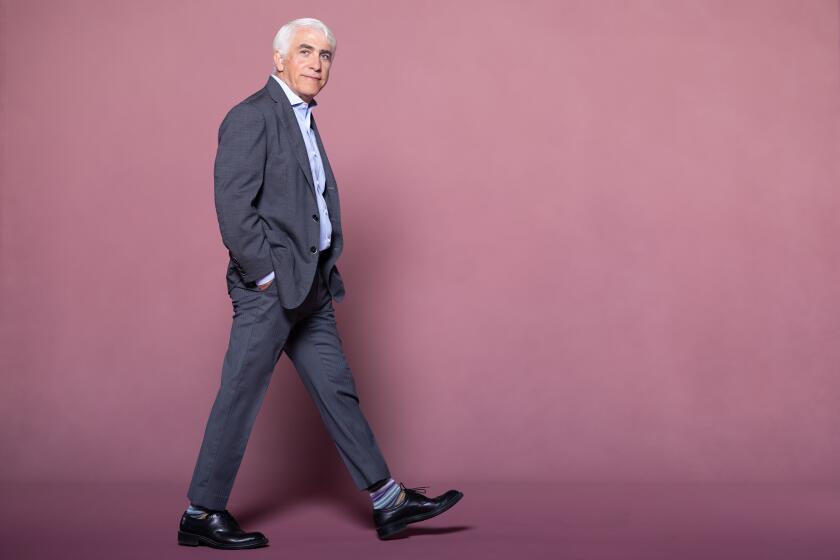
- Share via
If the new apartment tower had been planned for another plot of land, chances are good the concrete plant in the middle of the city would have helped build it.
But, as it happens, the century-old facility on La Brea Avenue that has provided concrete for buildings and roads across the Los Angeles region sat where the tower is to go up.
The West Adams project is the latest Shaul Kuba real estate transformation. Critics cry gentrification. The CIM co-founder says it’s a value-driving revival.
Now, the West Hollywood facility has ceased operating in order to make way for a new apartment tower.

The mixing plant that routinely filled fleets of trucks with ready-to-pour concrete stood out as an urban oddity in its final years, a dusty, noisy industrial yard on busy La Brea Avenue near Santa Monica Boulevard, across the street from a shopping center with a Target store.
Straddling the border between West Hollywood and Los Angeles, it backed up against L.A.’s burgeoning Sycamore District that includes upmarket stores, restaurants and art galleries that have sprung up in the former industrial district.
The Cemex Hollywood Concrete Plant was one of the last industrial businesses operating in West Hollywood, said Jennifer Alkire, the city’s assistant director of community development.

“It was definitely an unusual use, particularly as the city continued to develop and change and grow,” she said. “Obviously, it was there long before the city incorporated” in 1984.
A 1924 issue of Concrete magazine said that the operation at 1000 La Brea Ave. appeared to be “the pioneer mixing plant in the West,” the first of its kind offering “ready-mixed Portland cement concrete in quantities sufficient for a flagpole foundation or a 12-story building, and delivered right on the job when required.”
While concrete had been a preferred construction material for hundreds of years, it was 20th century advances in truck technology that made it practical to be delivered instead of mixed on-site.
By 1924, concrete from the La Brea plant was being used to pave streets in Los Angeles, the magazine said. Customers included the Standard and Union oil companies, along with the Famous Players-Lasky, Buster Keaton and Vitagraph movie studios.
Ready-mix concrete plants continued to support development in the Southern California region during the building boom of the post-World War II era, according to research prepared for a draft environmental impact report on the planned development of the La Brea Avenue site. The plant there was upgraded in the 1930s and 1960s and operated continuously until its closure a few weeks ago.
As mechanical plants go, it was a pretty simple one. Nearly vertical conveyor belts lifted dry ingredients high up to be deposited into hoppers where they were mixed with water and then the wet concrete was poured into waiting trucks below. Concrete trucks routinely queued up on nearby streets before departing right on La Brea Avenue with their agitator drums turning.
Its last operator, Mexican multinational building materials company Cemex, declined to comment on the closure. The company’s landlord, Los Angeles developer CIM Group, said Cemex’s lease on the property was set to expire at the end of November and that it would clear the site of structures and vacate. By the end of October, most of the plant had been disassembled and carted away.
CIM Group is seeking approval from the city of West Hollywood to build a 514-unit apartment complex that would fill much of the former plant site and another parcel on La Brea Avenue. Called 1000 La Brea, it would rise 34 stories and include floor retail space for shops and restaurants.
It would have rooftop gardens, a swimming pool, fitness center, yoga room and library. There would be subterranean and above-ground parking, and at least 20% of the units are expected to be designated as affordable with subsidized rents.

Shaul Kuba, co-founder of CIM Group, said he expects being situated on the edge of the upscale Sycamore district will help the apartment building land tenants. Neighbors would include Hollywood production facilities such as the former Warner Bros. studio now known as the Lot and other entertainment businesses, including broadcaster Sirius XM studios and Jay-Z’s entertainment company.
“This should become a place where people in the entertainment industry in the neighborhood can live and actually be close to their work,” he said. “The entertainment industry is very focused in this area right now.”
The east side of West Hollywood has evolved from being a collection of mostly low-rise commercial buildings, Alkire said, to including several multistory mixed-use residential buildings and neighborhood-serving retail properties such as the Movietown Square apartments and the West Hollywood Gateway shopping center.
California cities need more apartments to meet housing goals, she said. “It’s definitely been made a priority by our City Council and by the state.”
CIM hopes to break ground on the project next year and complete it by 2028, Kuba said.
More to Read
Inside the business of entertainment
The Wide Shot brings you news, analysis and insights on everything from streaming wars to production — and what it all means for the future.
You may occasionally receive promotional content from the Los Angeles Times.












